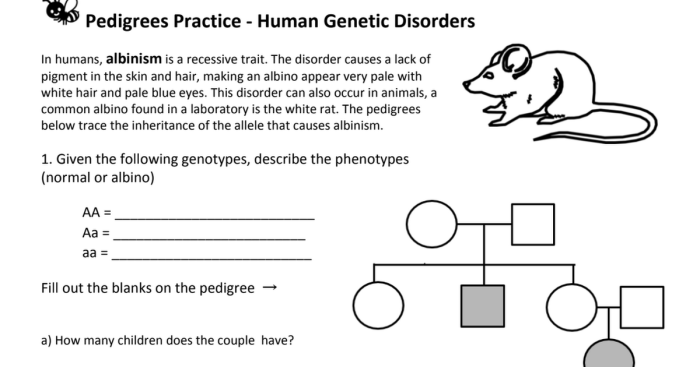The pedigrees practice human genetic disorders answer key PDF provides a comprehensive resource for understanding the principles and applications of pedigree analysis in the study of human genetic disorders. This guide offers a step-by-step approach to analyzing pedigrees, identifying inheritance patterns, and determining the mode of transmission.
Pedigrees are essential tools for tracing the inheritance of genetic traits and disorders within families. They allow researchers and clinicians to visualize the transmission of genetic information across generations, identify patterns of inheritance, and estimate the risk of developing genetic disorders in family members.
1. Introduction: Pedigrees Practice Human Genetic Disorders Answer Key Pdf
Pedigrees play a pivotal role in understanding human genetic disorders. They are graphical representations of family trees that depict the inheritance patterns of traits and disorders within a family. Pedigrees enable researchers and clinicians to trace the transmission of genetic information through generations, providing valuable insights into the genetic basis of diseases.
There are various types of pedigrees, each with its own applications. Vertical pedigrees show the inheritance of traits over multiple generations, while horizontal pedigrees focus on a single generation. Consanguinity pedigrees are used to study the effects of inbreeding, and cytogenetic pedigrees include information about chromosomal abnormalities.
2. Pedigree Analysis

Step-by-Step Guide, Pedigrees practice human genetic disorders answer key pdf
Pedigree analysis involves a systematic approach to identify patterns of inheritance and determine the mode of transmission. Here’s a step-by-step guide:
- Collect family history:Gather information about the affected individuals, including their symptoms, age of onset, and family relationships.
- Draw the pedigree:Create a graphical representation of the family tree, using standard symbols to denote affected and unaffected individuals.
- Identify patterns:Look for patterns in the pedigree, such as vertical or horizontal transmission, consanguinity, and multiple affected individuals within a family.
- Determine mode of inheritance:Based on the patterns observed, determine the mode of inheritance, such as autosomal dominant, autosomal recessive, X-linked, or mitochondrial.
- Confirm with genetic testing:In some cases, genetic testing may be necessary to confirm the mode of inheritance and identify the specific genetic mutation responsible for the disorder.
Examples of Pedigree Analysis
- Autosomal dominant inheritance:In Huntington’s disease, affected individuals have a 50% chance of passing on the mutated gene to each of their children. Pedigrees typically show vertical transmission with multiple affected individuals in each generation.
- Autosomal recessive inheritance:In cystic fibrosis, both parents must carry the mutated gene to have an affected child. Pedigrees often show horizontal transmission with unaffected parents having multiple affected children.
- X-linked inheritance:In hemophilia A, the mutated gene is located on the X chromosome. Males are typically affected, while females can be carriers. Pedigrees show horizontal transmission with affected males and carrier females.
Query Resolution
What is a pedigree?
A pedigree is a diagram that represents the family relationships and inheritance of traits or disorders within a family.
What is the purpose of pedigree analysis?
Pedigree analysis is used to identify patterns of inheritance, determine the mode of transmission, and assess the risk of developing genetic disorders in family members.
How do I interpret a pedigree?
To interpret a pedigree, you need to understand the symbols and abbreviations used to represent individuals, relationships, and genetic traits.
What are the different types of pedigrees?
There are different types of pedigrees, including vertical pedigrees, horizontal pedigrees, and circular pedigrees.